Secret ballot
The secret ballot, also known as the Australian ballot or Massachusetts ballot,[1] is a voting method in which a voter's choices in an election or a referendum are anonymous. This forestalls attempts to influence the voter by intimidation, blackmailing, and potential vote buying. This system is one means of achieving the goal of political privacy.
| Part of the Politics series | ||||||||
| Balloting | ||||||||
|---|---|---|---|---|---|---|---|---|
|
||||||||
| Electoral systems | ||||||||
|
||||||||
| Voting strategies | ||||||||
|
||||||||
| Voting patterns and effects | ||||||||
|
||||||||
| Electoral fraud | ||||||||
|
||||||||
| Politics portal | ||||||||
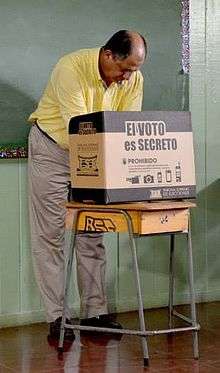
Secret ballots are used in conjunction with various voting systems. The most basic form of a secret ballot utilizes blank pieces of paper upon which each voter writes his or her choice. Without revealing the votes to anyone, the voter folds the ballot paper in half and place it in a sealed box. This box is later emptied for counting. An aspect of secret voting is the provision of a voting booth to enable the voter to write on the ballot paper without others being able to see what is being written. Today, printed ballot papers are usually provided, with the names of the candidates or questions and respective check boxes. Provisions are made at the polling place for the voters to record their preferences in secret, and the ballots are designed to eliminate bias and to prevent anyone from linking voter to ballot.
A privacy problem arises with moves to improve efficiency of voting by the introduction of postal voting and electronic voting. Some countries permit proxy voting but some people argue that this is inconsistent with voting privacy.
History
In ancient Greece, secret ballots were used in several situations[2] like ostracism and also to remain hidden from people seeking favors.
In ancient Rome, the laws regulating elections were collectively known as Tabellariae Leges, the first of which was introduced in 139 BC (lex Gabinia tabellaria).[3]
Today, the practice of casting secret ballots is commonplace. Many voters would not consider that any other method might be used, however other methods which had been used and which are still used in some places and contexts include "oral votes", as well as open ballot systems which involve the public display of votes or roll calls. Other public voting methods include raising a hand to indicate a vote or using coloured marbles or cards to indicate a voting choice.
France
Article 31 of the Constitution of the Year III of the Revolution (1795)[4] states that "All elections are to be held by secret ballot". The same goes with the constitution of 1848:[5] voters could hand-write the name of their preferred candidate on their ballot at home (the only condition was to write on white paper[6]) or receive one distributed on the street.[7] The ballot was folded in order to prevent other people from reading its contents.[7]
Louis-Napoléon Bonaparte attempted to abolish the secret ballot for the 1851 plebiscite with an electoral decree requesting electors to write down "yes" or "no" (in French: "oui" or "non") under the eyes of everyone. But he faced strong opposition and finally changed his mind, allowing the secret ballot to take place.[8]
According to the official web site of the Assemblée nationale (the lower house of the French parliament), the voting booth was permanently adopted only in 1913.[9]
United Kingdom
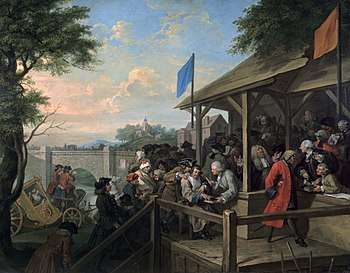
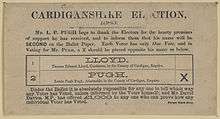
The demand for a secret ballot was one of the six points of Chartism.[10] The British parliament of the time refused to even consider the Chartist demands, but it is noted that Lord Macaulay, in his speech of 1842, while rejecting Chartism's six points as a whole, admitted that the secret ballot was one of the two points he could support.
The London School Board election of 1870 was the first large-scale election by secret ballot in Britain.
After several failed attempts (several of them spearheaded by George Grote[11]), the secret ballot was eventually extended generally in the Ballot Act 1872, substantially reducing the cost of campaigning (as treating was no longer realistically possible) and was first used on 15 August 1872 to re-elect Hugh Childers as MP for Pontefract in a ministerial by-election following his appointment as Chancellor of the Duchy of Lancaster. The original ballot box, sealed in wax with a licorice stamp, is held at Pontefract museum.[12]
However, the UK uses numbered ballots in order to allow courts to intervene, under rare circumstances, to identify which candidate voters voted for.
Australia and New Zealand
In Australia, secret balloting appears to have been first implemented in Tasmania on 7 February 1856.
Until the original Tasmanian Electoral Act 1856 was "re-discovered" recently, credit for the first implementation of the secret ballot often went to Victoria, where it was pioneered by the former mayor of Melbourne, William Nicholson,[13] and simultaneously South Australia.[14] Victoria enacted legislation for secret ballots on 19 March 1856,[15] and South Australian Electoral Commissioner William Boothby generally gets credit for creating the system finally enacted into law in South Australia on 2 April of that same year (a fortnight later). The other Australian colonies followed: New South Wales (1858), Queensland (1859), and Western Australia (1877). New Zealand implemented secret voting in 1870.
State electoral laws, including the secret ballot, applied for the first election of the Australian Parliament in 1901, and the system has continued to be a feature of federal elections and referenda. The Commonwealth Electoral Act 1918 does not explicitly set out the secret ballot but a reading of sections 206, 207, 325, 327 of the Act would imply its assumption. Sections 323 and 226(4) do however, apply the principle of a secret ballot to polling staff and would also support the assumption.
United States
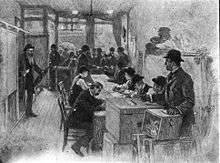
Before 1890, partisan newspapers printed filled-out ballots which party workers distributed on election day so voters could drop them directly into the boxes. All of the states replaced these with secret ballots around 1890, popularly called "Australian ballots." They were printed by the local government and listed all the candidates impartially.[16]
The "Australian ballot" is defined as having four parts:[17]
- an official ballot being printed at public expense,
- on which the names of the nominated candidates of all parties and all proposals appear,
- being distributed only at the polling place and
- being marked in secret.
In the United States, most states had moved to secret ballots soon after the presidential election of 1884. Kentucky was the last state to do so in 1891, when it quit using an oral ballot. But seven states did not have government-printed ballots until the 20th century. South Carolina created them in 1950 and Georgia in 1922.[18]
The first city to start using the Australian ballot in the United States was Louisville, Kentucky. They used a ballot drafted by Lewis Naphtali Dembitz, the uncle of and inspiration for future Supreme Court associate justice Louis Brandeis. The first state to adopt the Australian ballot was Massachusetts. For this reason it is also known as the "Massachusetts ballot". In the U.S., voting by secret ballot was universal by 1892 but criminal prohibitions against paying people to vote were only instituted in 1925.[19]
Elections in the United States are mostly held by secret ballot,[20] although some states use mail ballots instead, which violate requirements 3 and 4 of the "Australian ballot", as it is distributed to the home, and potentially marked in the presence of other people. The states of Colorado, Oregon, and Washington conduct all elections by mailed ballots.[21] The Constitution for the state of West Virginia still allows voters to cast "open ballots".[22]
International law
The right to hold elections by secret ballot is included in numerous treaties and international agreements that obligate their signatory states:
- Article 21.3 of the Universal Declaration of Human Rights states, "The will of the people...shall be expressed in periodic and genuine elections which...shall be held by secret vote or by equivalent free voting procedures."[23]
- Article 23 of the American Convention on Human Rights (the Pact of San Jose, Costa Rica) grants to every citizen of member states of the Organization of American States the right and opportunity "to vote and to be elected in genuine periodic elections, which shall be by universal and equal suffrage and by secret ballot that guarantees the free expression of the will of the voters".[24]
- Paragraph 7.4 of the Document of the Copenhagen Meeting of the Conference on the Human Dimension of the CSCE, obligates the member states of the Organization for Security and Cooperation in Europe to "ensure that votes are cast by secret ballot or by equivalent free voting procedure, and that they are counted and reported honestly with the official results made public."[25]
- Article 5 of the Convention on the Standards of Democratic Elections, Electoral Rights and Freedoms in the Member States of the Commonwealth of Independent States obligates electoral bodies not to perform "any action violating the principle of voter's secret will expression."[26]
Disabled people
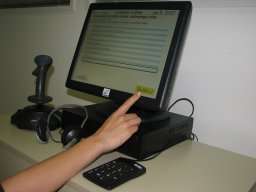
Ballot design and polling place architecture often denies the disabled the possibility to cast a vote in secret. In many democracies disabled persons may vote by appointing another person who is allowed to join them in the voting booth and fill the ballot in their name.[27] This does not assure secrecy of the ballot.
The United Nations Convention on the Rights of Persons with Disabilities which entered into force in 2008 assures secret ballot for disabled voters. Article 29 of the Convention requires that all Contracting States protect "the right of the person with disabilities to vote by secret ballot in elections and public referendums". According to this provision, each Contracting State should provide for voting equipment which would enable disabled voters to vote independently and secretly. Some democracies, e.g. the United States, the Netherlands, Slovenia, Albania or India allow disabled voters to use electronic voting machines. In others, among them Azerbaijan, Canada, Ghana, the United Kingdom, and most African and Asian countries, visually impaired voters can use ballots in Braille or paper ballot templates. Article 29 also requires that Contracting States ensure "that voting procedures, facilities and materials are appropriate, accessible and easy to understand and use." In some democracies, e.g. United Kingdom, Sweden and the United States, all the polling places already are fully accessible for disabled voters.
Secrecy exceptions
The United Kingdom secret ballot arrangements are sometimes criticised because it is possible to link a ballot paper to the voter who cast it. Each ballot paper is individually numbered and each elector also has a number. When an elector is given a ballot paper, their number is noted down on the counterfoil of the ballot paper (which also carries the ballot paper number). This means, of course, that the secrecy of the ballot is not guaranteed, if anyone can gain access to the counterfoils, which are locked away securely before the ballot boxes are opened at the count. Polling station officials colluding with election scrutineers may therefore determine how individual electors have voted.
This measure is thought to be justified as a security arrangement so that if there was an allegation of fraud, false ballot papers could be identified. The process of matching ballot papers to voters is formally permissible only if an Election Court requires it; in fact the Election Court has rarely made such an order since the secret ballot was introduced in 1872. One example was in a close local election contest in Richmond-upon-Thames in the late 1970s with three disputed ballots and a declared majority of two votes. Reportedly prisoners in a UK prison were observed identifying voters' ballot votes on a list in 2008.[28] The legal authority for this system is set out in the Parliamentary Elections Rules in Schedule 1 of the Representation of the People Act 1983.[29]
In the United States, most states guarantee a secret ballot. But some states, including Indiana and North Carolina, require the ability to link some ballots to voters. This may for example be used with absentee voting to retain the ability to cancel a vote if the voter dies before election day.[30][31] Sometimes the number on the ballot is printed on a perforated stub which is torn off and placed on a ring (like a shower curtain ring) before the ballot is cast into the ballot box. The stubs prove that an elector has voted and ensure that they can only vote once, but the ballots themselves are both secret and anonymous. At the end of voting day, the number of ballots inside the box should match the number of stubs on the ring, certifying that every ballot was cast by a registered elector, and that none of them were lost or fabricated. Sometimes the ballots themselves are numbered, making the vote trackable. In 2012 in Colorado, this procedure was ruled legal by Federal District Judge Christine Arguello, who determined that the U.S. Constitution does not grant a right to a secret ballot.[32]
Criticism
Some people believe that the secret ballot enables election fraud and so should be eliminated[33] or supplemented with other ways of verifying voting, such as cryptographically secure receipts.[34][35]
Chronology of introduction
| Date | Country | Notes |
|---|---|---|
| 1831 | France | Systems prior to 1856 (including those in France, the Netherlands, and Colombia), "merely required ballots to be marked in polling booths and deposited into ballot boxes, which permitted non-uniform ballots, including ballots of different colours and sizes, that could be easily identified as party tickets."[36] |
| 1849 | Netherlands | |
| 1853 | Colombia | |
| 1856 (February 7) | Australia (Tasmania) | The other Australian colonies of Victoria (March 19, 1856), South Australia (April 2, 1856), New South Wales (1858), Queensland (1859), and Western Australia (1877) followed. |
| 1861 | Italy | |
| 1861 | Ecuador | |
| 1866 | Sweden | Voter currently chooses party-specific ballot in the open, which has been criticised for limiting the secrecy. There is, however, the possibility to choose a blank ballot or a multitude of ballots to denote a specific party and candidate in secrecy.[37] European Commission for democracy through law (Venice Commission) “Voters are entitled to [secrecy of ballot], but must also respect it themselves, and non-compliance must be punished by disqualifying any ballot paper whose content has been disclosed […] Violation of the secrecy of the ballot must be punished, just like violations of other aspects of voter freedom.” (Code of good practice in electoral matters, art. 52, 55 |
| 1867 | Germany | August 1867 North German federal election, see also Frankfurter Reichswahlgesetz 1849 |
| 1870 | New Zealand | |
| 1872 | United Kingdom | Ballot Act 1872 |
| 1872 | Switzerland[38] | |
| 1874 | Canada | |
| 1877 | Belgium | The Act of 9 July 1877 or "Malou Act", based on the British Ballot Act 1872 |
| 1879 | Serbia[39] | |
| 1885 | Norway | |
| 1891 | United States of America | Massachusetts was the first state to adopt a secret ballot, in 1888, and South Carolina was the last to do so, in 1950. |
| 1900[40] | Japan | |
| 1901 | Denmark | In connection with The Shift of Government (Danish: Systemskiftet)[41] |
| 1903 | Iceland | Originally passed by the Icelandic parliament in 1902, but the legislation was rejected by King Christian IX for technical reasons unrelated to ballot secrecy.[42] Passed into law 1903.[43] |
| 1906 | Russia | |
| 1907 | Austria | |
| 1907 | Finland | |
| 1912 | Argentina | Sáenz Peña Law |
| 1918 | Poland | |
| 1918 | Uruguay | |
| 1919 | Romania | |
| 1925 | Costa Rica | |
| 1931 | Peru | |
| 1932 | Brazil | |
| 1939 | Hungary | Secret ballot system was already applied at the 1920 elections, but in 1922 the government reinstated open voting in the countryside. Between 1922 and 1939, only the voters in the capital (Budapest) and larger cities could vote with secret ballot. The electoral law passed in 1938 introduced the nationwide secret ballot system again. |
| 1946 | Venezuela | |
| 1950 | Turkey | |
| 1950 | El Salvador |
See also
- Open ballot voting
- Ballot
- Election fraud
- Voter suppression
Notes
- "Australian ballot | politics". Encyclopedia Britannica.
- Saalfeld, Thomas. 1995. On Dogs and Whips: Recorded Votes. In: Herbert Döring. Parliaments and Majority Rule in Western Europe. New York : St. Martin's Press, 1995. Page 531
- Tabellariae Leges. William Smith, D.C.L., LL.D.: A Dictionary of Greek and Roman Antiquities, John Murray, London, 1875.
-

- Article 24. — Le suffrage est direct et universel. Le scrutin est secret. s:fr:Constitution du 4 novembre 1848
- Pour être recevable, chaque vote doit être inscrit sur un papier blanc : fr:Élection présidentielle française de 1848
- See the picture captioned Distribution des bulletins d'élections dans les rues. L'Illustration du 23 septembre 1848 on Assemblée Nationale website
- Karl Marx The Eighteenth Brumaire of Louis Napoleon : For the bourgeois and the shopkeeper had learned that in one of his decrees of December 2 Bonaparte had abolished the secret ballot and had ordered them to put a "yes" or "no" after their names on the official registers. The resistance of December 4 intimidated Bonaparte. During the night he had placards posted on all the street corners of Paris announcing the restoration of the secret ballot. Full text (chapter VII)
- Nationale, Assemblée. "Le suffrage universel - Histoire - Assemblée nationale". www.assemblee-nationale.fr. Retrieved 24 March 2018.
- In the words of the petition that was published in 1838:
- Kinzer, Bruce (2004), "George Grote, the Philosophical Radical and Politician", Brill's Companion to George Grote and the Classical Tradition, London: Brill, pp. 16–45
- "BBC - A History of the World - Object : Pontefract's secret ballot box, 1872". www.bbc.co.uk. Retrieved 24 March 2018.
- Blainey, G 2016, ‘’The story of Australia’s people: the rise and rise of a new Australia’’, Viking, Penguin Random House, Ringwood, Victoria, Australia, p.18.
- Terry Newman, "Tasmania and the Secret Ballot" (PDF). (144 KiB) (2003), 49(1) Aust J Pol & Hist 93, accessed May 20, 2015
- "Documenting Democracy". foundingdocs.gov.au. Retrieved 24 March 2018.
- Eldon Cobb Evans, A History of the Australian Ballot System in the United States# (1917) online.
- Webster's Seventh New Colligiate Dictionary. Springfield, Massachusetts: G&C Merriam Company. 1967. p. 59.
- See 1922 Georgia session laws, chapter 530, p. 100.
- "18 U.S. Code § 597 - Expenditures to influence voting". LII / Legal Information Institute. Retrieved 24 March 2018.
- The party nominating caucuses in some U.S. states (most significantly the leadoff Presidential nominating state of Iowa) still require an open casting of ballots.
- Washington Secretary of State. "Vote by Mail in Washington State". State of Washington. Retrieved 27 April 2014.
- See W. Va. Const. Art. IV, §2, "In all elections by the people, the mode of voting shall be by ballot; but the voter shall be left free to vote by either open, sealed or secret ballot, as he may elect.".
- "Universal Declaration of Human Rights". www.un.org. Retrieved 24 March 2018.
- American Convention on Human Rights, "Pact of San Jose", Costa Rica, Organization of American States, Nov. 22, 1969.
- Document of the Copenhagen Meeting of the Conference on the Human Dimension of the CSCE, Copenhagen, June 29, 1990.
- Convention on the Stnadards of Democratic Elections, Electoral Rights and Freedoms in the Member States of the Commonwealth of Independent States, Oct. 7, 2002, Chisinau. Unofficial English translation provided by the European Commission for Democracy through Law (Venice Commission), Jan. 22, 2007.
- Mercurio, Bryan (2003). "Discrimination in Electoral Law". Alternative Law Journal. 28: 272–276.
- "What happens to the voting slips used in British elections after they have been counted? | Notes and Queries | guardian.co.uk". www.theguardian.com.
- "Factsheet: Ballot secrecy" (PDF). Archived from the original (PDF) on 2008-12-09. (48 KiB) (2006), Electoral Commission of the United Kingdom
- "2020 Indiana Election Administrator's Manual" (PDF). in.gov.
- Wilkie, Jordan (2019-07-11). "'A risk to democracy': North Carolina law may be violating secrecy of the ballot". The Guardian. ISSN 0261-3077. Retrieved 2020-03-02.
- "Federal judge says no constitutional right to secret ballot in Boulder case". 21 September 2012. Retrieved 24 March 2018.
- Lynne Landes. "Scrap the "secret" ballot - return to open voting".
- "Evolving Meaning of the Secret Ballot". voicevote.org.
- Todd Davies. "Consequences of the Secret Ballot" (PDF). Symbolic Systems Program, Stanford University.
- Ben Smyth, A foundation for secret, verifiable elections, IACR Cryptology ePrint Archive, 2018
- Radio, Sveriges. "Inget ökat skydd av valhemligheten 2018 - Nyheter (Ekot)". Retrieved 24 March 2018.
- Mackie, Thomas T. and Rose, Richard; The International Almanac of Electoral History ; p. 421 ISBN 1349098515
- Goldstein, Robert J.; Political Repression in 19th-Century Europe; p. 15 ISBN 0389204196
- "国立国会図書館デジタルコレクション - 法令全書. 明治33年". kindai.ndl.go.jp. Retrieved 24 March 2018.
- Elklit, Jørgen (1988). Fra åben til hemmelig afstemning. Århus, Denmark: Politica. pp. 299 ff.
- Stjórnartíðindi [Legal Gazette] (in Icelandic). Icelandic Government. 1902. pp. 273–275.
- Alþingistíðindi [Parliamentary Gazette] (in Icelandic). Alþingi. 1903. pp. 120–133.
External links
- The Ballot Bill [UK] - The Annual Register, 1872, page 61.
| Wikisource has original text related to this article: |